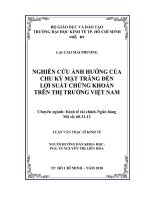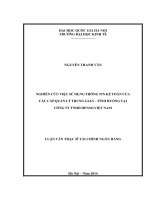Nghiên cứu việc sử dụng chuyển mã ngôn ngữ của các giám khảo trong các chương trình giải trí trên truyền hình Việt Nam (Luận văn thạc sĩ)
Bạn đang xem bản rút gọn của tài liệu. Xem và tải ngay bản đầy đủ của tài liệu tại đây (831.43 KB, 52 trang )
THAI NGUYEN UNIVERSITY
SCHOOL OF FOREIGN LANGUAGES
NGUYEN THI NGAN
A STUDY OF JUDGES’ CODE – SWITCHING ON
VIETNAMESE TV GAME SHOWS
(Nghiên cứu việc sử dụng chuyển mã ngôn ngữ của các giám khảo
trong các chương trình giải trí trên truyền hình Việt Nam)
M.A THESIS
Field: English Linguistics
Code: 8220201
THAI NGUYEN - 2019
THAI NGUYEN UNIVERSITY
SCHOOL OF FOREIGN LANGUAGES
NGUYEN THI NGAN
A STUDY OF JUDGES’ CODE – SWITCHING ON
VIETNAMESE TV GAME SHOWS
(Nghiên cứu việc sử dụng chuyển mã ngôn ngữ của các giám khảo
trong các chương trình giải trí trên truyền hình Việt Nam)
M.A THESIS
(APPLICATION ORIENTATION)
Field: English Linguistics
Code: 8220201
Supervisor: Dr. Nguyen Thi Hang
THAI NGUYEN – 2019
DECLARATION
I hereby warrant and declare that the thesis entitled “A study of judges’ code
– switching on Vietnamese TV game shows” is my own work to the best of my
knowledge and belief. It contains no material previously published or written by
another person (except where explicitly defined in the acknowledgements) and has
not been submitted previously, in whole or in part, for the award of any other
academic degree or diploma.
Signature:
Name: Nguyen Thi Ngan
Supervisor’s signature
Dr. Nguyen Thi Hang
i
ACKNOWLEDGEMENTS
This is my first experience for doing a thesis. I would like to express my deep
indebtedness to my supervisor, Dr. Nguyen Thi Hang, for her wholehearted
assistance. This thesis would not have finished without her suggestions, corrections
and encouragements.
My special thanks also go to my all colleagues in Centre for Human Resource
Development for Foreign Language Studies – Thai Nguyen University facilitate in
my studying process.
Furthermore, I am grateful to all authors of books listed in the bibliography,
whose ideas are good references for my research to be conducted and developed.
Last but not least, I am indebted to my little family and my best friends, Phuong
and Yen, who always understand, support and motivate me to finish my thesis.
ii
ABSTRACT
This study examines the code – switching phenomenon practiced by the judges
in the context of Vietnamese TV game shows. A mix of quantitative and qualitative
approach was applied to obtain the research aims, i.e., the frequency, types and
functions of code – switching. My analysis of data shows that factors such as the time
where the game shows took place, the theme of the game shows, the audiences for
each show and the judges’ social background decide the frequency of the judges’
switching]. Their switching have been classified into three types namely intra –
sentential code – switching, inter – sentential code – switching and tag – switching.
These switches serve two main functions: discourse and social functions. Subfunctions under each category have also been identified in the study.
iii
TABLE OF CONTENTS
DECLARATION ........................................................................................................ i
ACKNOWLEDGEMENTS ....................................................................................... ii
ABSTRACT .............................................................................................................. iii
LIST OF TABLES .................................................................................................... iv
Chapter 1: Introduction ...........................................................................................1
1.1. Rationale ......................................................................................................1
1.2. Objectives ....................................................................................................2
1.3. Research questions ......................................................................................2
1.4. Scope of the research ..................................................................................3
1.5. Research struture ........................................................................................3
Chapter 2: Literature Review ..................................................................................4
2.0. Introduction ................................................................................................4
2.1. Bilingualism ...............................................................................................4
2.2. Code – switching ........................................................................................5
2.2.1. Concepts of code – switching ..................................................................5
2.2.2. Types of code – switching .......................................................................6
2.2.3. Functions of code – switching ................................................................10
2.3. Summary ...................................................................................................13
Chapter 3: Research methodology ........................................................................14
3.0. Introduction ..............................................................................................14
3.1. Research methodology .............................................................................14
3.2. Data collection .........................................................................................15
3.3. Data analysis .............................................................................................16
3.4. Summary ...................................................................................................17
Chapter 4: Findings and Discussion ......................................................................18
4.0. Introduction ..............................................................................................18
4.1. Frequency of the judges’ code – switching .............................................18
4.2. Code – switching types..............................................................................21
4.2.1. Intra – sentential code – switching (type 1) ...........................................22
iv
4.2.2. Inter – sentential code – switching (type2) ............................................24
4.2.3. Tag – switching (type 3) .........................................................................26
4.3. Functions of code – switching ...................................................................27
4.3.1. Discourse functions ...............................................................................27
4.3.2. Social functions ......................................................................................31
4.4. Summary ...................................................................................................35
Chapter 5: Conclusion ............................................................................................36
5.1. Summary of key findings ..........................................................................36
5.2. Implications, limitations and suggestions for further research .................37
References ................................................................................................................39
List of tables
Table 3.1. Summary of game shows and episodes
v
Table 4.1. Judges’ switching times in each game show
Table 4.2. Types of code – switching
Table 4.3. Judges’ intra – sentential code – switching
Table 4.4. Judges’ inter – sentential code – switching
Table 4.6. Judges’ tag – switching
Table 4.7. Functions of the judges’ code – switching
Table 4.8. A list of words for the judges’ qualification
vi
Chapter 1: Introduction
1.1.
Rationale
“No nation in the world is completely monolingual” (Miriam, 2006). Vietnam,
a multi-ethnic nation with over 50 ethnic groups, is not an exception. Besides, many
foreign languages, i.e., English, Chinese and Japanese, are utilized in Vietnam.
Among these foreign languages, English is the most popular one which is used in
both educational and non – educational settings. The inserting of English to
Vietnamese conversations between people, who share their first language, has been
known as the phenomenon of code – switching. This practice seems to be
appropriately popular in social and educational, formal and informal situations.
Vietnam is in the most brilliant stage of game show development. Every year,
hundreds of entertainment programs or TV game shows are screened. According to
Vietnam Television Audience Measurement (Vietnam – TAM) statistic figure, there
are over 140 game shows published in Vietnam in 2016 (Vietnam-TAM, 2016).
Some well-known programs are The voice; Sing my song; The face Vietnam;
Vietnam next top model; The remix new generation. They seem to be the one that
most Vietnamese audience watch and follow. It is rather common to find
Vietnamese people speaking both Vietnamese and English as illustrated in the
following example:
Example 1.1:
Tôi rất thích đoạn
(I really like the
của bài hát của bạn.
chorus
chorus
part in your song)
(Sing my song 2016, episode 1, 45:56)
Studies on the practice of code – switching in Vietnam are mainly found in the
language teaching and learning context. Examples of these studies are English –
Vietnamese code – switching in tertiary educational context in Vietnam (Nguyen,
2012); Vietnamese university EFL teacher’s code – switching in classroom
instruction (Nguyen, 2013); Code – switching in English Language Education:
Voices from Vietnam (Nguyen, 2016). However, little has been known so far
1
concerning this practice on game shows. It is observed that both judges and
participants involved code – switching between Vietnamese and English rather
frequently in interactions in their shows.
Vietnamese authors tend to examine code – switching in fields such as
education, social network, and so on, in both written and spoken language.
However, very few of them are interested in the code – switching on Vietnamese
television. This study, therefore, expects to grasp understanding of judges’ code –
switching on Vietnamese TV game shows – a little part of language code –
switching between English and Vietnamese.
1.2.
Objectives
As mentioned, this study aims to gain better understanding of code – switching
employed by judges in game shows, the specific objectives are as follow.
- To obtain the frequency of code – switching used by judges on some popular
Vietnamese TV game shows.
- To identify their kinds of code – switching
- To determine the functions of their switches.
1.3. Research questions
The overarching research question has been formulated to achieve the
objectives:
How do judges code – switch between Vietnamese and English in
interactions on Vietnamese TV game shows?
Sub-questions are:
(1) How frequently is code – switching taken by judges on Vietnamese TV
game shows?
(2) What kinds of code – switching are used by the judges on Vietnamese TV
game shows?
(3) What functions do their switches take?
2
1.4. Scope of the research
This study focuses on the phenomenon of code-switching employed by judges
in Vietnamese game shows, especially oversea licensed programs in which the
young are interested. In this research, 71 videos will be used and collect from some
famous game shows which are The face Vietnam (2016), Sing my song (2016),
Vietnam’s next top model (2015, 2016,), Master chef Vietnam (2015), Miss
Universe Vietnam (2017).
1.5. Research structure
The research consists of five chapters, as follow:
-
Chapter 1: Introduction
-
Chapter 2: Literature review
-
Chapter 3: Research methodology
-
Chapter 4: Findings and discussion
-
Chapter 5: Conclusion
3
Chapter 2: Literature review
2.0. Introduction
This chapter reviews the phenomenon of code – switching, a main feature of
bilingualism. The first section provides an overview of the notion of bilingualism.
It continues with an in-depth discussion and synthesis in regard to aspects of code
– switching: the concept of code – switching, its types and functions, from different
scholars’ point of views. The chapter ends in a summary of all points presented.
2.1. Bilingualism
The notion of bilingualism in sociolinguistics has been accepted at least from
three main perspectives. The first group of scholars such as Mackey (1970), Romaine
(1995) views bilingualism as any bilinguals who master two languages equally. In
other words, this concept focuses on the balance of the languages involved, or on
fully – fluent bilinguals. With an emphasis on the equal ability of a bilingual to speak
two languages, Romaine (1995) asserts that bilinguals are those who have native –
like control of two languages.
The second group, in contrast, hold the idea that an individual’s ability to speak
both languages despite having low proficiency in either of them can be seen as
sufficient for him/her to be considered a bilingual. According to Haugen’s (1953)
view, bilinguals are individuals with proficiency in one language but with “the ability
to produce complete meaningful utterances in the other language” (p.7). This
approach has been accepted by other authors such as Hamers and Blanc (2000) and
Myers-Scotton (2006), who claim that rarely are speakers equally fluent in two
languages.
The third group of authors do not seem to approve of the two above opinions,
not seeing the ability of bilinguals in two languages, ranging from a maximal
proficiency to a minimal proficiency in a second language. They, therefore, defined
bilinguals without mentioning the speakers’ level of proficiency in either language,
as speakers using two or more languages alternately (Baetens Beardsmore, 1982;
Edwards, 2004; Mackey, 2000; Romaine, 1995).
4
Code – switching, one of the three main features of bilingualism, and also the
topic of the study, is reviewed below.
2.2. Code – switching
As “a complex research topic” in Bell’s (2014) view, code – switching has
been approached differently in the literature. This section deals with this
phenomenon with respect to its concept, classification and functions.
2.2.1.
Concept of code – switching
The phenomenon of code – switching has been accepted at least from three
main perspectives in bilingualism. The first group of scholars defined code –
switching only occurred among bilinguals. That was the transfer of words from one
language to another by bilinguals (Weinreich, 1953 – pp.73,74). Code – switching
was identified by Gardner-Chloros (2009) as “the use of several language dialects in
the same conversation or sentence by bilingual people” (p. 4). Dialect here can be
seen as a language code in sociolinguistic.
The second group defined code – switching base on language proficiency of
speaker. It was the result of lexical gaps in both languages (Deuchar and Quay, 2000)
or result of lacking the appropriate lexicon (Brice and Anderson, 1999; Meisel, 1994).
Speaker switched when there were two languages in the brain of certain individuals
(Myers-Scotton, 1990) but their language proficiency was unbalance between the first
and second languages.
The most general definition of code – switching is “the alternate use of two
languages or linguistic varieties within the same utterance or during the same
conversation” (Hoffmann, 1991, p. 110). That similar to an alternation of words and
phrases between two languages or dialects in definitions of Myers-Scotton (1990),
Gumperz (1982), and Wardhaugh (2011). Gardner Chloros (2009) defined code –
switching was the use of various languages or dialects within the same sentence or
conversation. Similarity, code – switching is used to refer to the phenomenon when
speaker “switch backwards and forwards between distinct code in their repertoire”
(Bell, 2014 – p.111). With the same perspective, Halmari (2004) called it was “the
mixing of two or more languages within the same conversational” (p.115). By means
5
of juxtaposition, i.e., elements of different languages put next to each other, Gumperz
(1982) defines conversational code-switching as “the juxtaposition within the same
speech exchange of passages of speech belonging to two different systems or
subsystems” (p. 59).
2.2.2.
Types of code – switching
Numerous scholars around the world classified the types of code – switching
with other point of views. Bloom and Gumperz (1972) differentiated two types of
code – switching, namely situational code – switching and metaphorical code –
switching (or conversational code – switching), on the basis of sociolinguistic factors.
Situational switching refers to circumstances where speakers switch languages due to
a change in the situation, such as a change in participant, topic or setting.
Metaphorical switching takes place in cases “the speaker decides to ignore the
observable external situation and focus instead on less observable characteristics of
code – switching of the people concerned” (Hudson, 1996, p. 53).
In her seminal work, Poplack (1980) analysed the speech of 20 Puerto Rican
residents, whose first language is Spanish, living in the United States of America to
test a hypothesis concerning the degrees of bilinguals’ ability in English. Poplack
(1980) classified the Puerto Rican residents’ code – switching into three types: Intra
– sentential code – switching, inter – sentential code – switching and extra –
sentential code – switching, also known as tag switching.
Intra – sentential code – switching occurs where switches of different types
occur within the clause boundary, including within the word boundary. The shift was
done in the middle of a sentence, with no interruptions, hesitations, or pauses to
indicate a shift. The speaker is usually unaware of the shift. This is the most complex
type of code – switching, in Poplack’s view, mainly because of the high probability
of violation of syntactic rules, as well as the requirement of a great command of both
languages and how they can map onto each other.
Example 2.1 (switching Spanish and English)
Leo un magazine
(I read a magazine)
6
(Poplack, 1980, p. 583)
Inter – sentential code – switching refers to the switches at clause/sentence
boundary, one clause being in one language, the other clause in the other (i.e., one
independent clause/sentence in one language, the other in another language). In other
word, the language switch is done at sentence boundaries – words or phrases at the
beginning or end of a sentence. This type is seen most often in fluent bilingual
speakers.
Example 2.2
Sometimes I'll start a sentence in Spanish y termino en Espaňol
(Sometimes I'll start a sentence in Spanish and finish it in Spanish)
(Poplack, 1980)
Extra – sentential code – switching (or tag – switching) occurs when the
speakers insert a tag, e.g. “wow”, “yeah”, “you know”, “I mean” from one language
into an utterance which is entirely in another language. This type of code – switching
is very simple and does not require a great knowledge of both languages, since there
is a minimum risk of violation of grammatical rules.
Example 2.3
But I wanted to fight her con los punos, you know.
(But I wanted to fight her with my fists, you know)
(Poplack, 1980, p. 596)
In example 2.3, the tag “you know” was inserted by the speaker at the end of
the sentence in English.
It seems that Poplack’s typology of code – switching has been adopted by a
number of scholars in different contexts among which the language classroom setting
has attracted many researchers.
One of these includes language classrooms in the multilingual context of Kenya.
Merritt et al. (1992) used ethnographic observations of classroom interaction to
explore teachers’ code – switching types. These authors classified the types of
teachers’ code – switching based on the content of the information of the switches in
their instruction, rather the linguistic units or the social aspects, i.e., the situation and
7
the topic. Their inductive analysis suggested four types of code – switching. They
describe their first two types (type I and type II) as switches involving a whole
sentence or interactional move i.e., switching across languages: English, Kiswahili
and speakers’ mother tongue. The third type (type III) is related to teachers’
translation or word substitution i.e., switching within a sentence. The fourth type
(type IV) is identified as teachers’ switches with interactional particles, including
discourse markers (e.g., “now then”, “O.K.”, “All right”, “now”), and classroom
management routines (e.g., “again, big voice”, “speak loudly”, “someone else”)
(Merritt et al., 1992).
Merritt et al.’s (1992) type I and type II could be seen as Poplack’s (1980) inter
– sentential code – switching (i.e. switching between sentences). Their type III could
be Poplack’s (1980) intra – sentential (i.e. switching within a sentence). However,
their fourth type (type IV) does not appear to coincide with extra – sentential code –
switching (i.e. switching involving tags, fillers, etc.) in Poplack’s (1980)
classification because they did not seem to consider such discourse markers as tags,
but rather separate utterances.
Other studies of code – switching in this context are Brice (2000); Rezvani &
Raskh (2011) and Tayjasanant (2014). These studies also found the three types of
code – switching classified by Poplack (1980).
In Vietnam, some authors recently examined this phenomenon. For example,
Nguyen (2013) and Grant and Nguyen (2017) analysed 12 English teachers’ speech
and they found that they code – switched in five forms namely filler and tag
switching, parts of an utterance, whole utterances, marginal code – switching and
borrowing as code – switching. Nguyen’s (2013) category of code – switching is in
line with Poplack’s (1980) typology to the extent that the three types termed filler and
tag switching, parts of an utterance and whole utterances fit in Poplack’s (1980) types
of code – switching. Examples below are cited from Nguyen’s (2013) with respect to
the three switching types.
8
Example 2.4
T:
I want you Ờm (Erm) to look at the screen and tell me. [Showing
images] What are they?
(Nguyen, 2013, p. 83)
Example 2.5
T:
Bánh bích quy, right?
(Biscuit,
right?)
(Nguyen, 2013, p. 84)
Example 2.6.
T:
Và tất cả các con đường dẫn tới
mountains.
(And all the roads lead to
mountains)
(Nguyen, 2013, p. 87)
Nguyen’s switching type 1 involved fillers/tags (i.e., “À” (Ah), “Ờ”(Er), “Ờm”
(Erm), “Ừm” (Umm), “Ứm” (Umm), “Hừm” (Hmm)) or tags (i.e., “understand?”,
“right”, “okay”). The filler in example 2.4 is “Ờm (Erm)” and the tag in example 2.5
is “right”. They are similar to the tag in Poplack’s typology.
The switching involving parts of an utterance were in the form of a word or a
group of words from one language that they inserted into an utterance in the other
language. That is, speakers were speaking in one language and, in the same utterance,
they inserted a word or a group of words of the other language into that utterance, as
example 2.6. Speaker was speaking in Vietnamese, and they inserted the English
word “mountains” into their Vietnamese utterances. In other words, this switches
involving part of an utterance, i.e., single word in this case, occurred within an
utterance.
The third type of code – switching in Nguyen’s (2013) perspective was
switching involving whole utterances. That is, the speaker was using one language in
a utterance, then shift to another language in next utterance.
9
Example 2.7.
“Language” is the first noun of the compound. Ở đây có một 1 cái danh từ
ghép, đúng không ạ?
(“Language” is the first noun of the compound. There’s a compound noun
here, right?)
(Nguyen, 2013, p.91)
In example 2.7, speaker was speaking in English, i.e., “language” is the first noun of
the compound, and then shifted to Vietnamese in the whole next utterance, i.e., ở đây
có một 1 cái danh từ ghép, đúng không ạ. (one utterance was made in one language,
and the next utterance was in another language).
To date, there seems no evidence of the speakers’ switching in the contexts other
than classroom setting in Vietnam.
2.2.3.
Functions of code – switching
Many people believed that code – switching may be the deficiency or lack of
mastery of both languages of speakers. However, as a common feature of
bilingualism, code – switching serves different functions including discourse
functions and social functions.
Discourse functions
In 1982, Gumperz suggested functions of codeswitching, including quotations,
addressee specification, interjections, reiteration, and message qualification.
(Gumperz, 1982, pp.75-79).
First of all, Gumperz (1982) shows that code – switching has relevance in terms
of direct and reported speech. Bilingual speakers quote a message in one language
amidst the production of an utterance in the other language. This is the function of
quotations making. Quotation is used when, for example, person A wants to report
something person B has said; person A is talking in English but inserts the reported
words of person B in Vietnamese.
Secondly, code – switching can be used in addressee specification which means
that by employing code – switching a person can direct his/her message to one of
10
possible addressees (Gumperz, 1982). Addressee specification can be used with
monolinguals and with bilinguals (Romaine, 1995). However, addressee specification
can also be used to exclude someone by code – switching to a language no one else
in the group understands apart from the speaker and his/her addressee.
Example 2.8.
Where ‘nother knife? walima pocket-knife karrwa-rnana?
(Where’s the other knife? Does anyone have a pocket knife?)
(McConvell, 1988, p. 135)
The example 2.8 was from a bilingual speaker living in an Australian village.
The speaker switches from Kriol (an English-based Creole spoken by Aborigines) to
Gurindji (spoken in the Wave Hill area as 2nd or often 3rd or 4th language by Whites
and Aborigines). His/her switch “walima” “karrwa-rnana” (Does anyone have a)
implies the group of butchers who are indirectly spoken to (McConvell, 1988).
Thirdly, interjection occurs when code – switching is used to mark an
interjection or serve as sentence fillers (Gumperz, 1982, pp.77-78). This can be tag –
switching according to Poplack’s (1980) notion.
Fourthly, reiteration occurs when a message is repeated in another language.
That is, the repetition may serve to clarify or emphasise a message.
Finally, code – switching is also used to qualify a message. That is, a message
is introduced in one language and qualified or expressed in another way in another
language.
Example 2.9.
The oldest one, la grande la de once años
(The oldest one, the big one who is eleven years old)
(Gumperz, 1982, p. 79)
The example 2.9 above is a sentence in English and Spanish, where the speaker
starts the subject in English (i.e., the oldest one) and switches to Spanish (i.e., la
grande la de once años) to qualify the subject.
11
Social functions
Social function is “the main cause for code – switching” (Auer, 1995) when
speakers negotiate a change in social distance between themselves and other
participants in a conversation (Hawazen, 2012). It performs in social relations
between interlocutors, in establishing and maintaining social identity.
As stated, Bloom and Gumperz (1972) classified code – switching to two types
including situational code – switching and metaphorical code – switching (or
conversational codeswitching). Although Myers-Scotton (1993) doubts about how
these two functional types are classified, she notes that situational code – switching
is motivated by changes in factors external to the participants’ own motivations, and
conversational code – switching is understood as a shift in topic and in other extra
linguistic context markers that characterise the situation.
Other authors (e.g., Auer, 1998; Baker, 2006; Hoffmann, 1991) also examined
the phenomenon of code – switching and found other social functions of this
phenomenon. They found that code – switching can serve as a means for expressing
group identity (an in-group marker) and solidarity with such a group (Auer, 1998;
Hoffmann, 1991). As Myers-Scotton (1993), the different language choices used in
other communities by speakers of different social backgrounds reveal different
identities, or social roles. Thus, social functions of code – switching can be
understood as the functions that code – switching performs in social relations between
interlocutors, in establishing and maintaining social identity. In addition, Baker
(2006) considers one social function of speakers’ code – switching as marking
changes in attitudes or relationships with each other.
In Nguyen’s (2013) study, she examined 12 teachers’ speech and found two
main social functions of their switches, i.e., establishing good rapport and showing
shifts in attitude. The first social function, i.e., establishing good rapport, in her view
is when the speakers switched to joke, which had a positive effect on the listeners.
Such switches, from Nguyen’s (2013) perspective, served the purpose of building up
a good rapport between teachers and their students. “The attitude shift included:
commenting, criticising or even warning” (Nguyen, 2013, p.135). Similarity, some
12
researchers, i.e., Flyman-Mattson & Burenhult (1996); Sert (2005), employed social
function to refer to teachers’ switches that signal friendship or solidarity with their
students.
2.3. Summary
This chapter discussed two main phenomena including bilingualism and code –
switching. The first section gives an overview of bilingualism concept with three
groups of perspective, i.e., the people use two languages in equal, the unequal in two
languages proficiency of speaker, and the using of two or more languages alternately.
The next section provided a depth understanding of code – switching phenomenon in
some aspects such as concept, types and functions. The most common definition of
code – switching was the alternation of two or more languages in an utterance or
conversation. Whereby, its classification were inter – sentential, intra – sentential, tag
– switching (Poplack, 1980) or filler and tag switching, parts of an utterance, whole
utterances, marginal code – switching and borrowing as code – switching (Nguyen,
2013). Code – switching served two main functions, including discourse functions
and social functions.
13
Chapter 3: Research methodology
3.0. Introduction
This chapter discusses the research methodology applied in the study and the
issues related to it. As stated in Chapter 1, the study seeks for the answer for the
following overarching research question:
How do judges code-switch between Vietnamese and English in interactions on
Vietnamese TV game shows?
Specifically, it deals with points as follows:
(1) The frequency of judges’ code - switching in their interactions with
participants, also known as candidates, on Vietnamese TV game shows;
(2) The types of code - switching used by the judges on such game shows, and
(3) The functions their switches serve.
The chapter begins with a brief presentation of the research approach, i.e. a mix
of quantitative and qualitative research design. It then justifies the methodology
adopted in this study, which shapes the design in terms of the methods for collecting
and analysing data. The chapter ends with a summary regarding all points discussed.
3.1. Research methodology
A mix of qualitative and quantitative research design was adopted as the
research methodology in this study.
According to Osbaldeston (2008), qualitative research tends to give
researchers rich, detailed and emotionally driven insights based on their personal
views and views of the participants. In contrast, quantitative data provide
researchers with a broader and more robust view, from hard statistics. This is why
Anderson and Poole (1994) favored a combination of both approaches, as they
believe that they can maximize their strengths. Moreover, in Bryman’s (1992)
viewpoint, combining both approaches can reduce the potential danger from an
exclusive reliance on a single research approach. However, authors such as Brannen
(1992), Anderson and Poole (1994) claim that integration of both can be
problematic to researchers as this may raise issues.
14
A quantitative research in Kothari’s view is based on the measurement of
quantity or amount. It is applicable to phenomena that can be expressed in terms of
quantity (Kothari, 1990). Interpretation of the information, to some extent, needs to
be evaluated through numbers, in Bhattacherjee’s language, statistics driven the
researcher (Bhattacherjee, 2012).
On the contrary, qualitative approach is generally concerned with subjective
assessment of attitudes, opinions and behaviour (Kothari, 1990; Hammersley,
1992). Researchers usually work with documents such as text data and request the
researchers’ analytic and integrative skills and personal knowledge of the social
context (Bhattacherjee, 2012).
In this study, I adopted the Kothari’s approach to the extent that I based on the
analysis of numbers so that I obtain answers for my first and second research
questions, i.e. how frequently judges code – switch and what types of code –
switching used. The quantitative data were analyzed and processed using the
Microsoft Excel software which helped count the number of code – switching
instances. Then, I classified the types of code – switching by adopting Poplack’s
(1980) classification. The qualitative approach was more clearly shown in my data
collection and analysis of the functions of the judges’ switches in various situations
in the shows.
3.2. Data collection
As stated, I collected information from six popular game shows. These shows
took place from 2015 to 2017 on Vietnamese television. Table 3.1 below
summarizes the game shows and the number of episodes collected and used for
analysis.
Table 3.1. Summary of game shows and episodes
Game shows
Vietnam’s next top model
Length of a show
Seasons
Episodes
2015
11
550
2016
12
600
15
(mins)
Master Chef Vietnam
2015
15
750
The face Vietnam
2016
12
900
Sing my song
2016
10
900
Miss universe Vietnam
2017
11
250
71
3950
Total
Firstly, I downloaded a total of 71 videos of six game shows from YouTube
channel, then watched every video carefully and took notes. This was done for my
preliminary analysis. Difficulties vary in this phase, particularly the time devoted
and my patience. It took much time for me to watch and follow a total of 71 videos,
about 60 minutes each, possibly resulting in my mistakes during my collection and
analysis the data obtained. Therefore, I greatly attempted to minimize errors by
watching again and again where necessary and taking notes. The second problem
was the judges’ voice. The Vietnamese tones, which cause speaking mistakes, are
different from English. Some English words they sounded were difficult for me to
hear, leading to misunderstanding. There were times when I found hard to
understand what judges said, even in their mother tongue because they live in
different parts of Vietnam where accents are much stronger in some, i.e. the
pronunciation of Vietnamese are dissimilar. Dialects were frequently uttered.
However, I with great support from my students and colleagues, I finally completed
my work and collected enough data for this research.
3.3. Data analysis
In Vietnam, various game shows have been flourishing over a period of 10
years, and there are shows with far more fans than others. In my observation, the
shows, which have been most interest of audiences, include Vietnam’s next top
model, The face Vietnam, Sing my song, Master Chef Vietnam and Miss Universe
Vietnam. Many of these shows are adapted from Western shows. This is the reason
why I decided to choose these programmes as a source of information for analysis.
More importantly, I have chased these shows, seeing that the judges tend to insert
16
English into their speech when they interact with the show takers, or even with other
judges within the show.
I only concentrated on the judges’ speech, which was examined for the study
purpose. This work required my carefulness because if I had not been meticulous, I
would have missed their switches, which might negatively affect the research result.
While watching and listening, I picked up any switches and put them in a table with
labels created using Microsoft Office Excel i.e. number, sentences, time, types of
code – switching and sources. This helped me to count the judges’ switches so that
I could gain an understanding of how frequently they code – switched between their
mother tongue and English. Next, I made a list of the judges’ utterances in which
there were switches. In another table with no labels but numbers, I classified all the
utterances on the list and based on the similarities and differences of the switching.
Then I compared my categories with Polack’s types of code – switching. Finally,
from my categories of the judges’ switching types, I attempted to reason why they
code – switched and what function their switches served.
3.4. Summary
A mix of qualitative and quantitative approach was adopted to this study as the
research methodology which frames my study, from designing the research (i.e.
formulating research question and collecting and analysing the information) to
interpreting and discussing the results. This helps to well address the research
question and, thus, I was able to find the answers for all points concerning the
frequency of the judges’ switching, the types of the switch as well as what functions
that the switches take. Details of what I found are discussed in the next chapter.
17

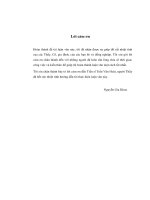
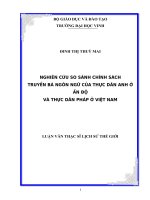
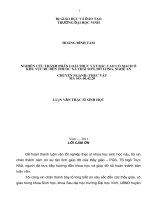
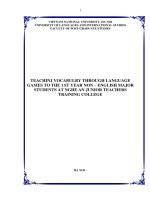
![Nghiên cứu việc sử dụng phần mềm cabri 3D của giáo viên trong giảng dạy hình học không gian chương quan hệ song song và quan hệ vuông góc lớp 11 trung học phổ t[171058]](https://media.store123doc.com/images/document/2015_03/30/medium_bhC5GHS4CA.jpg)

